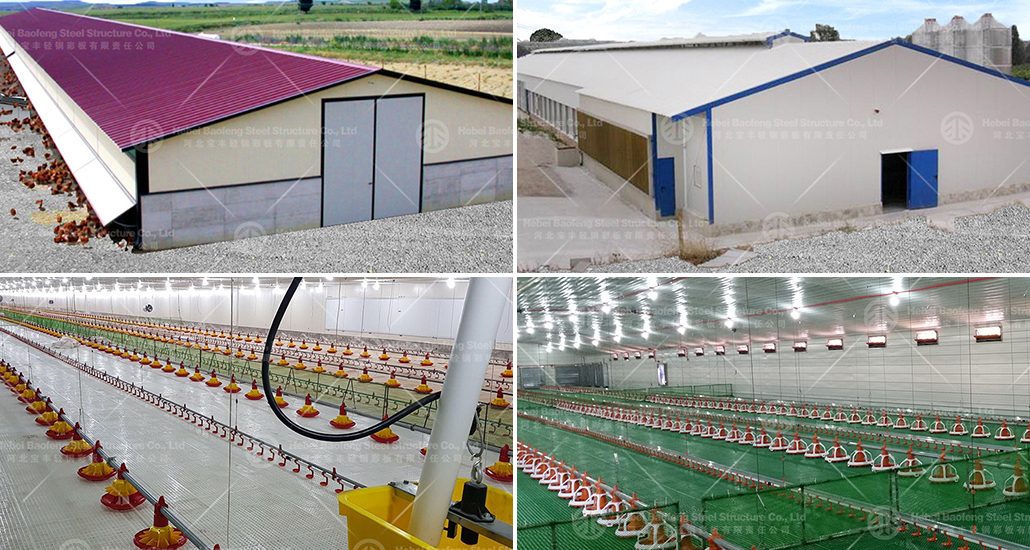
How much land do you need for a poultry farm?
The amount of land needed for a poultry farm depends heavily on several key factors, primarily the type of poultry operation and its scale.
Here’s a detailed breakdown to help you understand the land requirements.
The Two Main Factors: Type of Operation and Scale
1. Type of Poultry Operation
This is the most significant factor.
A. Commercial Broiler (Meat Chicken) Farm:
System: Usually intensive, indoor production.
Land for Housing: A single modern broiler house can be 400-600 feet long and 40-60 feet wide (approx. 120m x 15m). This covers about 20,000-30,000 sq ft (1,860-2,800 sq m or ~0.5-0.7 acres) per house.
Total Land Needed: A typical farm might have 2 to 6 houses. You need significant space betweenhouses (for biosecurity, ventilation, and manure management) and around the perimeter (a buffer zone). Therefore, a 4-house broiler farm would likely need a total plot of 5 to 15 acres (2 to 6 hectares).
B. Commercial Layer (Egg Production) Farm:
System: Can be cage-free, aviary, enriched colony, or free-range.
Land for Housing: Layer houses are similarly large. The big difference comes if you have a free-range or pasture-based system.
Conventional (Caged/Indoor): Land requirement is similar to a broiler farm—focused on the house footprints and setbacks.
Free-Range/Pastured: This requires much more land. You need not only the housing but also ample outdoor ranging area.
Ranging Area: Recommendations vary, but a common guideline is 1-2 acres per 500-1000 birds. So, for a flock of 5,000 free-range layers, you might need 5 to 20 acres of pastureland in addition to the housing and infrastructure.
C. Pasture-Based/Pastured Poultry (Meat Birds):
System: Birds are raised in mobile pens ("chicken tractors") that are moved daily to fresh pasture.
Land Needed: This method is land-intensive but on a seasonal basis. A common rule of thumb is that you need about 1 acre of land to raise 500-1,000 broilers per year in a rotational system. The land is used for a season and can then be rested or used for other livestock.
D. Breeder Farm or Hatchery:
These facilities require similar housing to commercial farms but may have additional space for mating areas, egg handling, and incubation. Land requirements are comparable to intensive broiler/layer farms, with a focus on high-level biosecurity and buffer zones.
E. Backyard/Hobby Farm:
Scale: A small flock for family eggs/meat (e.g., 5-25 birds).
Land Needed: Very little. A sturdy coop needs maybe 50-100 sq ft (5-10 sq m), and a small run could be 100-200 sq ft. In total, you could comfortably keep a dozen birds in an area of less than 1/10th of an acre.
2. Scale of the Operation
This is simple math: the more birds you plan to raise, the more land you'll need, both for the buildings and for the surrounding infrastructure.
Land for More Than Just the Chicken House
Crucially, the total land parcel must accommodate much more than just the poultry buildings:
Setbacks and Buffers: You need space between buildings and from your property line to neighbors to manage odor, dust, and disease risk. This is often mandated by local zoning laws.
Manure Management: You need a designated, often covered, area for storing litter and manure before it is removed. This must be a specific distance from water sources.
Infrastructure:
Parking: For feed trucks, livestock transporters, and worker vehicles.
Feed Bin Storage: Area for large bulk feed bins.
Utilities: Access for water and electricity.
Mortality Management: A place for composters or incinerators to handle dead birds.
Future Expansion: It's wise to acquire more land than you initially need to allow for future growth.
Critical First Steps Before Buying Land
Check Zoning and Regulations: This is the most important step. Your county or local municipal government will have zoning laws that dictate if you can even have a poultry farm on a property, and what the minimum land size and setback requirements are.
Understand Environmental Regulations: There will be strict rules about managing waste and protecting water sources. You may need a permit.
Consider Topography and Drainage: The land should be well-drained and not prone to flooding.
In short, there is no one-size-fits-all answer. A small backyard flock can fit on a fraction of an acre, while a large commercial free-range egg operation could require well over 50 acres. Always start your planning with your local regulations and a clear business plan defining your operation type and scale.

Categories
latest blog
Tags